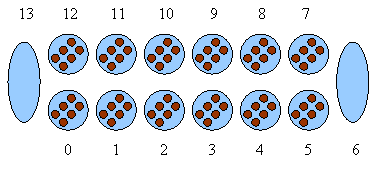

Kalah is played on a board that consists of 14 bowls arranged as shown above. The six small bowls at the bottom of the board belong to Player #1; they are numbered (counter-clockwise) 0 through 5. The large bowl at the right - bowl number 6 - also belongs to Player #1; it is Player #1's kalah.
Similarly, the six small bowls at the top of the board belong to Player #2, and are numbered (counter-clockwise) 7 through 12. The large bowl at the left - bowl number 13 - is Player #2's kalah.
At the beginning of the game each small bowl contains six stones, and the two kalahs are empty. Player #1 moves first.
A player moves by picking up all stones from one of his/her bowls, and dropping them, one stone per bowl, in the counter-clockwise direction. If the player reaches his/her kalah, then he/she drops a stone in it. The player does not drop a stone in the opponents kalah.
Example: Player #1 might begin the game by picking up and dropping the stones from bowl 4. As a result of that move, bowl 4 would contain 0 stones, bowl 5 would contain 7 stones, bowl 6 (Player #1's kalah) would contain 1 stone, bowl 7 would contain 7 stones, bowl 8 would contain 7 stones, bowl 9 would contain 7 stones, and bowl 10 would contain 7 stones.
If the player drops the last stone into his/her kalah, then the player moves again. Otherwise, the opponent moves.
Example: Player #1 might begin the game by picking up and dropping the stones from bowl 0. As a result of that move, bowl 0 would contain 0 stones, bowls 1, 2, 3, 4, 5 would contain 7 stones each, and bowl 6 (Player #1 kalah) would contain 1 stone. Since the last stone landed in Player #1's kalah, Player #1 moves again.
If the player drops the last stone into one of his/her own small bowls, and that bowl was previously empty, then the player removes the stone from that bowl and drops it in his/her kalah. The player also removes all stones from the bowl that is directly opposite that bowl, and drops them in his/her kalah.
Example: Suppose that Player #1 drops the last stone into bowl 1, and that bowl 1 was previously empty (i.e. it now contains only one stone). In that case, Player #1 picks up the stone from bowl 1, and drops it into his/her kalah (bowl 6). Player #1 then picks up all stones from the opposing bowl - bowl 11 - and drops them into his/her kalah.
When one player no longer has any stones in his/her small bowls, then all the stones that remain in the other player's small bowls, are placed in his/her kalah. At that point the game is over. Note that it is not necessarily advantageous to be the first player to empty all of the small bowls.
Example: Suppose that bowls 0 through 5 are empty. Then all stones from bowls 7 through 12 are placed in Player #2's kalah. The game is then over.
At the end of the game, whichever player has more stones in his/her kalah is the winner.